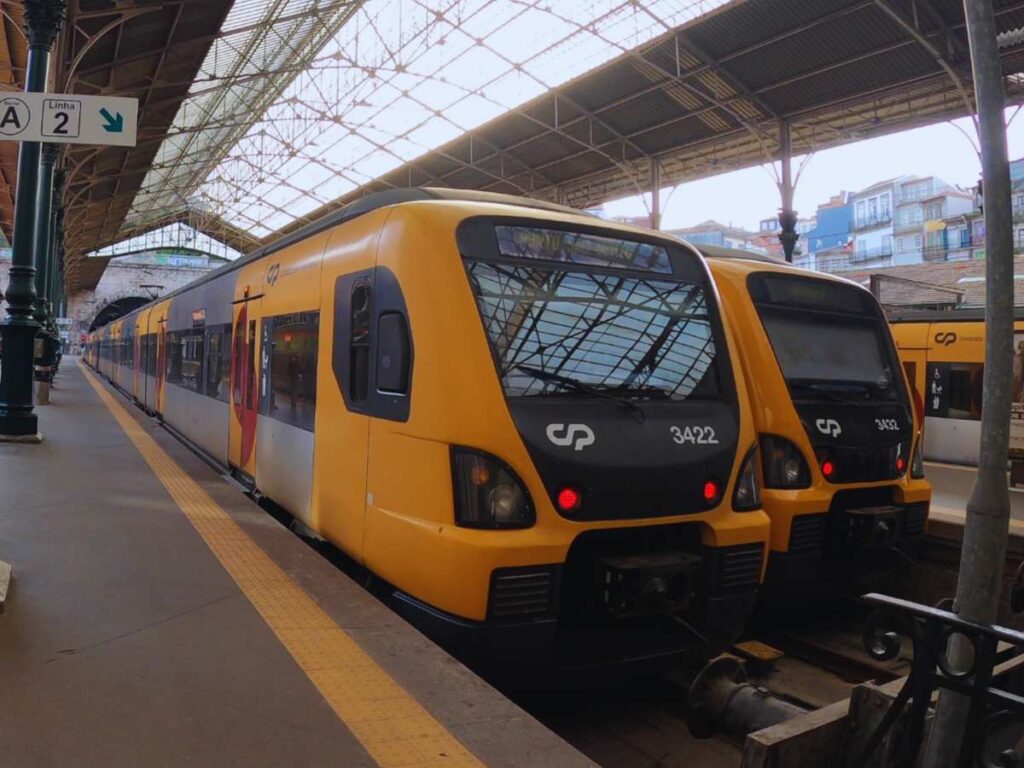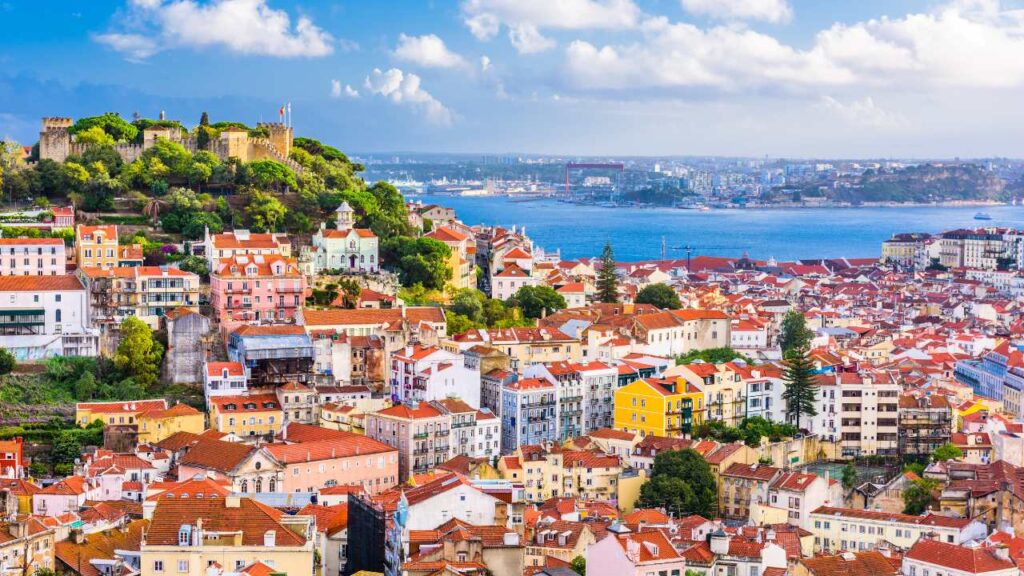
50 countries, 24 languages, and so much beauty, Europe is a treasure trove of beautiful destinations. You can spend a lifetime in Europe and never run out of new places to see, so in this Europe travel guide, we’re sharing countries specific travel guides, along with our best Europe travel tips on how to navigate the continent, what to see and do, and how to do it all affordably so you can travel more, while paying less.
Our Europe Travel Guides
1. How to Get Around Europe

Europe is extremely well-connected via bus, train, ferry, and plane, making it a breeze to get around the continent. If you would like to know the cheapest and fastest ways to get in between cities, then plot your route on the website Rome2Rio. This site can tell you the cost and duration of each mode of travel, making it easy to decide the best mode of transport for you.
For most of the major cities in Europe, it’s best to use public transportation to get around because car parking can be difficult to find and quite expensive. The only time renting a car can be useful is when you are planning a tour of the European countryside.
Disclaimer: This post includes affiliate links. Buying through our links is at no extra cost to you, but it supports our website and our travels as we will receive a small commission. We really appreciate the support!
Another thing to consider when renting a car in Europe is that there are not many automatic transmission vehicles available. Most car rentals in Europe will be manual transmission or stick shift. If you don’t know how to drive a manual transmission car, then you will need to reserve a car rental well in advance, as so few automatic car rentals are available.
Apart from exploring the countryside, stick to public transport and you’ll have a fun and affordable time on the continent. Usually, taking the bus will be the cheapest option in most European cities, but taking the train is usually faster and more comfortable and is the preferred option for most travelers. However, due to Europe’s fantastic budget airlines, sometimes it’s cheaper to fly than to take the train. Again, Rome2Rio can help you decide.
2. European Budget Airlines You Need to Know About

Flights in Europe are not nearly as expensive as they are in North America, meaning you can find budget airline flights for as little as €15 euros one-way. To get such low fares, it does require traveling light with just a backpack that can fit under the seat in front of you. Budget airlines charge an additional €50 euros for check baggage and to put carry-on bags in the overhead bins. Nonetheless, €65 euros for a plane ticket is still quite affordable and many times, these budget flights are cheaper and faster than taking a train.
When you are planning your European itinerary, make sure to search these budget airlines to see just how much you can save!
When booking with a budget airline, you just want to be sure that you read the terms and conditions very carefully. We once got the wrong flight package and purchased a carry-on baggage allowance instead of a checked baggage allowance. We were surprised that they would not switch our package to the checked baggage package, meaning we had to pay double for our luggage, €50 euros for carry-ons that we didn’t have and €50 euros for our checked baggage. So, it’s very important to read and understand the package that you are signing up for when using a budget airline. Nonetheless, with prices so cheap, we were still saving money.
However, if you can’t find the flight you need with a budget airline, you should also try Skyscanner to see the cheapest flights from your destination. This is a great tool to see what flights are available and what 3rd party booking sites have the cheapest fares.
3. Know the Schengen Zone Rules

In Europe, there is a Schengen zone where you can travel freely without traditional border crossing and passport checks. This makes country-hopping in the Schengen zone really easy. For example, you can travel between France, Spain, Portugal, Italy, and Germany without showing your passport because these countries are all in the Schengen zone.
Most tourists are allowed 90 days to tour the Schengen zone without applying for a visa. While 90 days is plenty of time for the average tourist, it can be a real challenge for the full-time traveler to navigate all 27 Schengen zone countries in such a short timeframe.
It can be easy to lose track of time while you are touring Europe, so it’s important to document your entry date and what the 90-day cut-off would be. Always try to leave 2-3 days before your 90 days are up to ensure that you don’t have any legal issues with immigration. You don’t want to threaten your ability to visit Europe in the future by staying longer than 90 days because there is absolutely no wiggle room on this one!
4. Money in Europe

In Europe, 25 countries use the euro, which is the most commonly used currency in the region. Other common currencies include the British pound, the Swiss franc, and countries like the Czech Republic, Iceland, Norway, Sweden, Denmark, Poland, and Hungary all have their own unique currencies as well.
The best way to access local currency is by using an ATM. This is especially true if you have a Charles Schwab debit card that has no foreign transaction fees and refunds all ATM fees. It’s also best to decline currency conversion when using European ATMs. This is because your bank’s exchange rate is usually much better than the ATM’s exchange rate. By declining the ATM conversion rate and allowing your bank to do the conversion, it can save you nearly $10-$30 per transaction.
Credit cards are widely used and accepted in Europe, however, it’s wise to have both a Mastercard and a Visa card with you. In some rural restaurants, they will only take one or the other. They won’t take both types of credit cards. In addition, it’s extremely rare to find a vendor who will take American Express or Discover, so don’t count on being able to use these cards very often in Europe.
Although credit cards are widely accepted, you will still need cash for street vendors, street food, and for bathrooms. So, make sure to always travel with some cash on you.
5. Tipping in Europe

My most valuable Europe travel tip for U.S. citizens is always about tipping. Tipping is very different in Europe as compared with North America. In Europe, restaurant tips can be as little as 5-10%. If you try to tip the typical 20% in Europe, the wait staff will literally look at you strangely, wondering why you are wasting money. I know because that’s happened to me before.
In France, it is typical to tip a flat rate of €2-5 euros at a restaurant. In Italy, it’s more like 10% of the bill is a good tip. In places like Iceland, tips are not expected at all as wages are high and service fees are included in the price. Since every country is so different, it’s best to research the tipping culture in each country separately. However, the good news is that you should not tip 20% in Europe. This travel tip alone could save you hundreds on your next trip.
6. Bathroom Breaks

In most countries in Europe, finding a public restroom can be a real challenge because you can’t just walk into a restaurant or a cafe to use the bathroom for free and leave. You either have to buy something in the shop or pay 50 cents to €1 euro to use the bathroom. Even gas stations in Europe charge to use the bathroom. So, if you are ever in Europe and are having trouble finding a toilet, I would recommend using Google Maps to find public restrooms near you. You can also try the Flush app to search for toilets, which lists both paid and free bathrooms to take the hassle out of finding a place to go when nature calls.
7. Stay Connected with an eSim

In order to navigate around Europe with Google Maps and the Flush App, it is essential to have mobile data, but international data roaming can be very expensive. This is why we always recommend getting an eSim as they are an affordable and reliable way to stay connected while you travel.
We’ve had great success using Airalo’s eSim! The set-up is really easy and we loved being able to search for restaurants, read the reviews to make sure we would get good service, and search for historical facts about the sights we were seeing. You can do so much more when you have the internet at your fingertips, so make sure to purchase your eSim before you go.
8. Power Adapters

The most common outlets in Europe are the British-style 3-pong plug and the European-style 2-rounded pong plugs. To be ready for both styles, it’s best to purchase a universal outlet adapter so you are ready for anything. Most power adapters come with 3-4 USB charging ports and one conventional plug.
If you need more plugs to charge multiple computers and cameras, then you may want to bring a travel power strip. There’s nothing worse than trying to take turns charging devices. It’s best to get a power strip that can charge everything at once.
9. What to Pack for Europe
In addition to your outlet adapter, the most important thing to bring to Europe is comfortable walking shoes because you are going to walk miles to see all of the beautiful attractions. Layers are also important so that you can remove layers as it gets warm and add layers as it gets chilly in the evenings.
It’s also nice to have a bag that has some anti-theft features. I really like the Travelon brand for this reason as they have zippers that lock so pickpockets can’t easily get into your bag and they have slash-proof materials that thieves can’t cut to access your wallet. It’s one way to keep your belongings safe while you travel Europe.

In general, you want to pack light for Europe. A good rule of thumb is that if you are unable to physically carry all of your luggage up one flight of stairs at the same time then you have packed too much.
10. Scams to Avoid in Europe

Although Europe is very safe, the biggest danger there is pickpockets. It’s important to stay alert and not be on your cell phone when using public transportation because pickpockets can use the minutes that you are staring at your phone to get your wallet.
You also want to avoid accepting any gifts from strangers, including friendship bracelets and roses. These scammers will say that these gifts are free, but later they will try to guilt you into paying money for them.
Also, avoid people with clipboards asking you to sign a petition because under the clipboard they are trying to pick your pocket or your purse. Just say, “No thank you,” and walk away.
11. What to Do in Europe

No matter what city you choose to start your European adventure, it will be easy to find plenty to do. We always recommend starting your stay off with a free walking tour with GuruWalks. This site has loads of tipped-based tours that you can take that will orient you when you first arrive and will give you some great insider tips on where to eat and what other attractions to see while you are in the city.
It’s also nice to take day trips to see the surrounding areas of a city, and Get Your Guide is a great option for tours and day trips that will really make any trip a special one. They also have really good food and wine tours, so you can sample the best local foods and drinks with a knowledgeable local guide because your enjoyment of a place increases 10-fold when you get to savor all of the unique local flavors.
12. Make Reservations at Popular Attractions
If you are going to a popular tourist destination like London, Paris, Barcelona, or Rome, then booking tickets in advance and making restaurant reservations is essential. Even while traveling in the off-season, there were museum exhibits that we could not see because tickets were sold out. And we almost missed seeing the Sagrada Familia in Barcelona because we didn’t know we needed to book tickets in advance. Luckily, we usually have multiple days in a city so we were able to come back the next day. But if you are short on time, book your activities in advance to avoid disappointment.
13. Don’t Travel Too Fast
Because Europe has so many cool places to explore, it can be tempting to want to spend one night here and two nights there in an attempt to see as much as possible. However, I would like to caution you against that. I recommend a minimum of 3-4 nights in every city you would like to see. This allows you time to travel and arrive at your new accommodation and it allows you 2-3 full days to explore the city and the surrounding areas. You are going to enjoy your European vacation so much more if you are spending more time sightseeing than you are in transit.
13. Download and Use Google Translate
Although English is widely spoken throughout Europe, you will inevitably have some lost-in-translation moments. This is part of the charm of traveling through Europe, but in order to make those awkward lost-in-translation moments as short as possible, it’s important to download Google Translate and download your destination’s language for offline use. This way no matter how many bars you have on your cell phone, you can still translate your voice and use your camera to translate signs and menus.
Google Translate has saved the day for us so many times in our travels, especially when it comes to figuring out how to use a washing machine on laundry day. Unfortunately, so many travelers forget to use it and feel that they can’t eat at local restaurants that don’t already have the menu translated into English. With Google Translate, you can and it’s completely free to use as well!
15. Where to Stay in Europe
It’s always best to book your accommodation in a centrally located area in Europe so that most attractions will be within walking distance of your accommodations. Alternatively, it’s also useful you book accommodations within a few minutes walk of a metro station or a bus stop so that it’s easier to get around.
For booking hotels, we find that Booking.com has the best selection and the cheapest prices. VRBO and Airbnb are also great options for finding apartments so that you can live like a local while you travel.
But if you want to dive deeper into our country-specific travel guides, then check out the travel guides below!
- Croatia Travel Tips
- Iceland Travel Guides
- Malta Travel Tips
- Portugal Travel Guides
- Slovenia Travel Guides
Pin this blog for later below!




